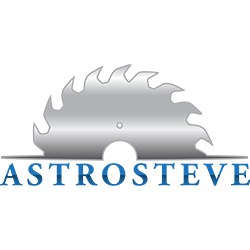This is an addendum to my YouTube video showing the feather boards. I’m adding a few more details here that I forgot to mention in the video, in case you are interested in making a feather board. In my future videos, I’ll try to start showing some of the actual process of making the projects, which will be a bit weird for me, filming while cutting wood. Please subscribe to my YouTube channel if you’d like to see these projects.
The standard feather board is 3 – 1/2″ wide, cut on a 60 degree angle, each finger is 1/8″ wide, with the 1/8″ saw cut. This seemed to give the right amount of stiffness to each finger. Each finger is 3 and 1/4″ long. The entire board is 8 1/2″ long. The slots are 3 – 1/4″ long each. I used 3″ 1/4 – 20 bolts with a countersink head.
I marked where the slots would go, to slide the feather board, then I used a router to cut those slots. I won’t go into any details on that, my slots didn’t come out very good, and I obviously need to find a better technique.

The miter slot piece starts as a little more than 1″ wide oak piece. I made these so they stick out past the feather board about 1.5″ on each side. Use your router with a flush trim bit and take off about 1/32″ on the wide part of the oak piece, leaving at least one inch on each end of the board. Rip this piece in half on your table saw, and turn the pieces 90 degrees to make a board that has a slot in the middle. Glue that together. I did use a Grr-Ripper to hold that narrow piece down when ripping it. That really helped and made the cut safer. Once the two pieces glued together dry, you’ll need to cut some off each side, so that the slot is centered and it fits into the miter slot. Make it so it slides easily, but has almost no play in the slot. The board should not be too thick and set up higher than the table saw. When you fit it in the miter slot, it should be thinner than the miter slot is deep. This allows saw dust to be in the slot, and not interfere with you sliding the feather board back and forth.

 The underside of the feather board showing the part that runs in the miter slot. Make sure this piece has very little play, so tightening the knobs will lock it easily. But not to tight, or it will be difficult to slide.
The underside of the feather board showing the part that runs in the miter slot. Make sure this piece has very little play, so tightening the knobs will lock it easily. But not to tight, or it will be difficult to slide.Mark where your holes need to go in the miter board. You’ll drill 1/4″ holes, centered where the slots are in the feather board. Then use a large countersink bit to allow space for the head of the 1/4 bolt. The idea is, when you tighten the knob, the bolt head will cause the miter board to spread apart slightly at the slot, to lock it into place in the miter slot, and at the same time, lock the feather board in place on the table.

My other feather board is shaped differently so that I can rip wider boards, and have a wider piece on the left side of the blade. It is more of a rectangular shape. It’s about 8.5″ x 4.5″, remember when cutting it out, to cut it so the feathers go with the grain. So you will end up cutting the pieces at an angle out of a larger board so the grain is the right way. Each end is cut about 1/4″ lower than the feathers stick out. Also on one end the feathers get shorter and shorter. I ended up cutting those off, as they were very stiff when shorter and had a different stiffness than the other feathers. The shortest feather is 2″ long, and the longest about 3.25″ long. I didn’t leave enough wood on the back, and it ended up splitting. I saved it by gluing an approximately 3/4 x 3/4″ piece along the back so the grain gave the feather board back its strength.

Here’s a list of parts used. Note that using these links supports this website, and won’t cost you anything more:
I couldn’t find a link for the bolts, but it is an easy to find 1/4″ – 20 x 3″ countersink bolt. The above knob is a 1/4″ – 20 knob, so will thread onto it. If you are only going to use a one layer thick feather board, you could use a shorter bolt. Also, the 3″ bolt works for two feather boards that are 3/4″ thick.
After making these, the first large board I needed to rip on my table saw was about 12″ wide, and the edge was right on the miter slot. Too wide to use either of my oak homemade feather boards. I ended up buying Magswitch Table Feather Board Universal Model so that I can magnetically put the feather board wherever I wish. I can also turn on and off the two magnets, so I can easily move it around. Of course, this only works for cast iron tables, if your’s is aluminum or non magnetic, it won’t work. This one works quite well, and really helps me guide the board along the fence much better. My next rip I needed to make after that allowed me to use one of my new oak feather boards, and it also worked very well.




